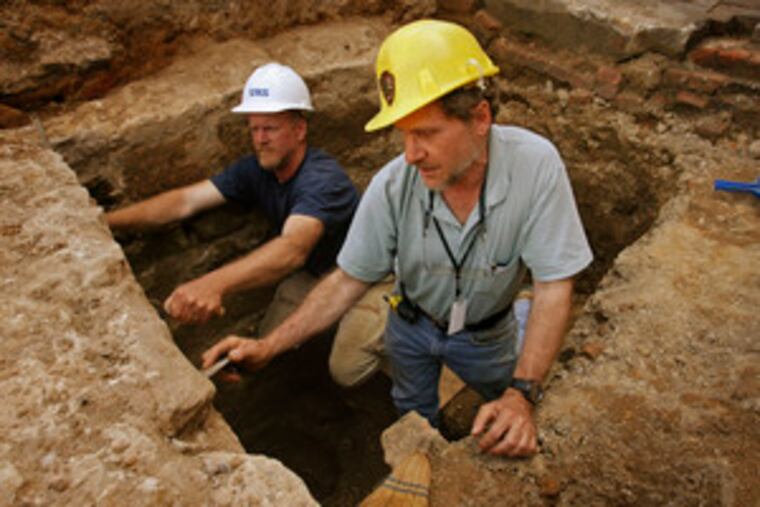Dig yields some unexpected finds
Among discoveries at President's House are foundation walls and a "mystery building."

Six weeks into the excavation of the site where George Washington and John Adams lived and conducted their presidencies, archaeologists have unearthed significant portions of the original President's House - the nation's first "White House" - including foundation walls of the house kitchen, where Washington's enslaved chef Hercules conjured up many a memorable meal.
"We uncovered much more than we thought we would," said Douglas Mooney, field director of the URS Group, a private firm conducting the dig in concert with the city and the National Park Service.
"We had no idea any of that was there," he continued. "We always thought those back buildings [including the house kitchen] were built on very shallow foundations. Now we can see most of the kitchen is there and the entire kitchen had a basement."
In addition to the unexpected finding of kitchen foundations, the excavation also has uncovered the rear wall of the main President's House, which stood at the southeast corner of Sixth and Market Streets until it was largely demolished in 1832.
Three commercial buildings then were constructed on the site, and the excavation has uncovered their foundations as well.
In fact, in one of the exciting moments of the dig, archaeologists broke through the cement basement of one commercial building last week and there, right on top of a remaining President's House foundation wall, was an 1833 penny. It was common practice for builders to place a properly dated coin beneath new construction - and the commercial building was, in fact, erected in 1833.
"It's unbelievable that we came down right on top of that, but it certainly dates it very accurately," Mooney said. "We couldn't believe it when that popped up. Sometimes you imagine what would be a really cool find, and sometimes you can't even predict."
In another unusual and unexpected discovery, archaeologists found another President's House foundation wall running from the main house, which fronted Market Street, back to the kitchen, 50 to 60 feet to the rear. It suggests strongly that there was a subterranean passage from the house basement to the kitchen basement, which would have been used to move food and goods without leaving the house.
At the back of the kitchen, an even deeper subbasement area was discovered that may have been a cold cellar or Washington's wine cellar.
Other findings so far include three so-called "shaft features."
One may have been an original well dug by the house's owner, Robert Morris, the well-known financier who loaned the house to Washington and then Adams, making it the nation's first seat of the executive branch.
A second shaft may have been a well Washington dug to replace the Morris well.
A third shaft, located near the rear of the kitchen, has dimensions typical of a privy. If that is what it proves to be - and archaeologists have yet to examine it - then it is possibly connected to the President's House and could yield substantial artifacts.
A singular mystery also has emerged from the dig: Archaeologists have found foundation walls from an undocumented building that fronted on Sixth Street and extended back through the rear of the President's House footprint.
Until further exploration is conducted, it is impossible to say when this building was constructed or what its relationship to the President's House may be.
"It's our mystery building," Mooney said.
The site as a whole covers about half an acre, with the floors of the basement nine or 10 feet below current street level. A platform for viewing the ongoing project has been set up along Market Street, and this week countless visitors have come to watch the work. Archaeologists and volunteers are almost always available to describe what visitors are looking at.
Work is still under way to clear what archaeologists call rough fill from the top of the site to get down to the historic level.
Once that is completed, probably this week, finer exploration of the various uncovered features can commence:
Examining the maze of walls remaining from the 18th and 19th centuries, which can help in dating various peculiar construction elements.
Digging out the shaft features and culling through the earth for artifacts, which could include just about anything, because privies were used as garbage dumps and are akin to gold mines for archaeologists.
That should all begin by the end of this week or the beginning of next week; work at the dig should be finished by the end of May.
The President's House site has been a subject of controversy since 2002, when The Inquirer reported that the entrance to the new Liberty Bell Center would compel visitors to walk over the spot where Washington quartered slaves during his presidency.
During various times in the 1790s, Washington harbored at least nine slaves in the house. Two of them escaped - Hercules, the fabled chef, and Oney Judge, Martha Washington's personal servant.
Adams, who succeeded Washington and lived in the house, flatly opposed slavery.
Following excavation, the site will become a memorial to the President's House and its residents, particularly the enslaved Africans. It will, in effect, become the nation's first commemoration of those who suffered through slavery.
.